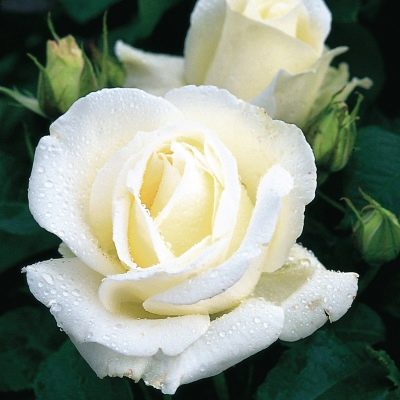
- Authors: Hans Jürgen Evers
- Name synonyms: Akito
- Breeding year: 1997
- Group: tea-hybrid
- The main color of the flower: white
- Flower shape: goblet
- Flower size: large
- Diameter, cm: 10-12
- Flower type by number of petals: medium terry
- Scent: sweet notes of strawberry and raspberry are felt
This rose was created in Germany as a result of selection in 1997. It belongs to the hybrid tea species. Most often, such a rose is used for cutting.
Description of the variety
This plant is an upright and dense bush. Its height is on average 50-100 centimeters, and its width is 60 cm. The leaves have a rich dark green color. Their surface is glossy. Shoots are rather thin and straight.
Large flowers are white in color, with a lemon-colored core. The shape of the flowers is goblet. Their average diameter is 10-12 centimeters.
By the number of petals, this rose is moderately double. Each flower contains 17-25 petals. Their location is solitary. One flower is placed on each stem.
The blossoming flowers have a sweet aroma with hints of strawberry and raspberry. The intensity of the aroma is weak. As the flowers age, small spots and smears of a darker color begin to form on their petals.
This rose is great for planting in the foreground. Dark foliage will contrast perfectly with light flowers. Often they are used when decorating flower beds in garden plots. Such flowers can be planted in whole groups to create a single beautiful composition.
Advantages and disadvantages
Among the advantages of such a rose, it is worth highlighting a beautiful decorative appearance, as well as high resistance to many diseases and pests, increased frost resistance (it can withstand temperatures up to -28 degrees).
It is also worth noting that this hybrid tea rose does not require any complicated special care. A little attention and care will be enough. This variety has practically no drawbacks.
Flowering features
Rose Akito begins to bloom in June. Her flowering is recurring. At first, fairly dense white buds are formed on the bushes. They have a classic form. Then lush, beautiful flowers develop from the buds.
Landing
This variety can be planted both in spring and autumn. For planting, holes are dug on the site with a depth of 55-60 centimeters. The seedlings are carefully lowered into the ground and covered with fertilized soil. The distance between individual bushes should be approximately 40-50 cm.
Growing and care
This vegetation will develop well and grow in partial shade and in illuminated areas. After planting, the plants will need to be watered once a week. In addition, the flower will need feeding. The best option for this variety will be special ready-made fertilizers for flowering plants.
This hybrid tea rose needs formative pruning in the spring and sanitary pruning in the fall. In summer, after flowering, all faded flowers should be removed. Pruning is a necessary procedure. It minimizes the threat of chopping flowers.
Although Akito is considered a frost-resistant variety, it is still better to cover the plants before the onset of winter. For this, the land around the bushes is well mulched with sawdust and dried foliage.
Remember that you should cover the rose only when cold weather is firmly established. Plants tolerate frosts down to -7 degrees. On the contrary, they will prepare the flower for the winter season.
Diseases and pests
The Akito variety is very resistant to diseases, including powdery mildew and black spot.If the vegetation was nevertheless infected with fungal diseases, then it should be treated with a soap-copper emulsion, a solution of Bordeaux liquid or ferrous sulfate. You can also use ready-made potent drugs ("Fundazol").
It is extremely rare that various pests appear on such a rose, including a spider mite, rose-colored aphid, and a leafworm. To get rid of all parasites, you should immediately use strong insecticides ("Aktara", "Fufanon"). You can also use homemade tinctures with laundry soap, hot peppers, tobacco.
Reproduction
This variety propagates by cuttings. It should be noted that only with this method will plants be able to maintain the main varietal characteristics.
Review overview
Many gardeners have left positive reviews about this variety of roses. It was noted that the plant has a beautiful decorative appearance. In addition, it has the longest flowering period.































































